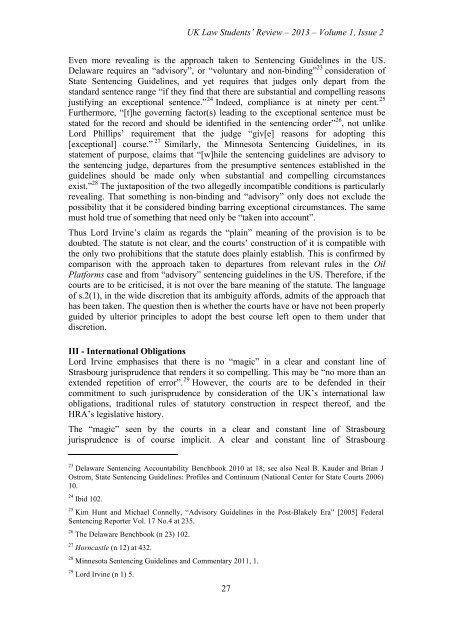Open UKLSR Volume 1(2) - Uklsa
Open UKLSR Volume 1(2) - Uklsa
Open UKLSR Volume 1(2) - Uklsa
You also want an ePaper? Increase the reach of your titles
YUMPU automatically turns print PDFs into web optimized ePapers that Google loves.
UK Law Students’ Review – 2013 – <strong>Volume</strong> 1, Issue 2<br />
Even more revealing is the approach taken to Sentencing Guidelines in the US.<br />
Delaware requires an “advisory”, or “voluntary and non-binding” 23 consideration of<br />
State Sentencing Guidelines, and yet requires that judges only depart from the<br />
standard sentence range “if they find that there are substantial and compelling reasons<br />
justifying an exceptional sentence.” 24 Indeed, compliance is at ninety per cent. 25<br />
Furthermore, “[t]he governing factor(s) leading to the exceptional sentence must be<br />
stated for the record and should be identified in the sentencing order” 26 , not unlike<br />
Lord Phillips’ requirement that the judge “giv[e] reasons for adopting this<br />
[exceptional] course.” 27 Similarly, the Minnesota Sentencing Guidelines, in its<br />
statement of purpose, claims that “[w]hile the sentencing guidelines are advisory to<br />
the sentencing judge, departures from the presumptive sentences established in the<br />
guidelines should be made only when substantial and compelling circumstances<br />
exist.” 28 The juxtaposition of the two allegedly incompatible conditions is particularly<br />
revealing. That something is non-binding and “advisory” only does not exclude the<br />
possibility that it be considered binding barring exceptional circumstances. The same<br />
must hold true of something that need only be “taken into account”.<br />
Thus Lord Irvine’s claim as regards the “plain” meaning of the provision is to be<br />
doubted. The statute is not clear, and the courts’ construction of it is compatible with<br />
the only two prohibitions that the statute does plainly establish. This is confirmed by<br />
comparison with the approach taken to departures from relevant rules in the Oil<br />
Platforms case and from “advisory” sentencing guidelines in the US. Therefore, if the<br />
courts are to be criticised, it is not over the bare meaning of the statute. The language<br />
of s.2(1), in the wide discretion that its ambiguity affords, admits of the approach that<br />
has been taken. The question then is whether the courts have or have not been properly<br />
guided by ulterior principles to adopt the best course left open to them under that<br />
discretion.<br />
III - International Obligations<br />
Lord Irvine emphasises that there is no “magic” in a clear and constant line of<br />
Strasbourg jurisprudence that renders it so compelling. This may be “no more than an<br />
extended repetition of error”. 29 However, the courts are to be defended in their<br />
commitment to such jurisprudence by consideration of the UK’s international law<br />
obligations, traditional rules of statutory construction in respect thereof, and the<br />
HRA’s legislative history.<br />
The “magic” seen by the courts in a clear and constant line of Strasbourg<br />
jurisprudence is of course implicit. A clear and constant line of Strasbourg<br />
23 Delaware Sentencing Accountability Benchbook 2010 at 18; see also Neal B. Kauder and Brian J<br />
Ostrom, State Sentencing Guidelines: Profiles and Continuum (National Center for State Courts 2006)<br />
10.<br />
24 Ibid 102.<br />
25 Kim Hunt and Michael Connelly, “Advisory Guidelines in the Post-Blakely Era” [2005] Federal<br />
Sentencing Reporter Vol. 17 No.4 at 235.<br />
26 The Delaware Benchbook (n 23) 102.<br />
27 Horncastle (n 12) at 432.<br />
28 Minnesota Sentencing Guidelines and Commentary 2011, 1.<br />
29 Lord Irvine (n 1) 5.<br />
27


